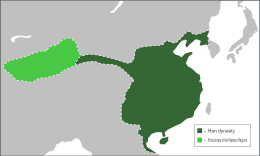| Han 漢 | |
|---|---|
| 202 BCE–220 CE | |
 The Han Dynasty in 2 CE with the Western protectorate in light green | |
| Dominant mode of production | Feudalism |
| Government | Monarchy |
| Area | |
• Total | 6,500,000 km² |
| Population | |
• 2 CE estimate | 57,671,400 |
The Han dynasty was the second dynasty of imperial China founded in 206 BCE as the successor of the Qin dynasty. Liu Pang, a peasant rebel who overthrew the Qin dynasty, became its first emperor.[1]
History
In 17 CE, following flooding in the Yellow River valley, Mother Lü led a rebellion that established two independent kingdoms. The Taoist Yellow Turbans led another rebellion in 184 with 360,000 armed supporters.[2]
Government
The first Han emperor banned merchants and their descendants from serving in government. The government taxed trade more than agriculture, and Emperor Wu, who ruled for 54 years, seized merchants' property.[2]
Economy
Classes
The Han dynasty's measures against the merchants did not significantly improve life for the peasants. They had to give a third to a half of their harvest to lords and often starved if harvests were bad.[2]
Means of production
The Han dynasty developed steel and wheelbarrows by the second century CE, over 1,000 years before Europe.[2]
References
- ↑ Neil Faulkner (2013). A Marxist History of the World: From Neanderthals to Neoliberals: 'Ancient Empires' (p. 36). [PDF] Pluto Press. ISBN 9781849648639 [LG]
- ↑ 2.0 2.1 2.2 2.3 Chris Harman (1999). A People's History of the World: 'Iron and empires' (pp. 57–61). [PDF] London: Bookmarks Publications Ltd. ISBN 9781898876557 [LG]